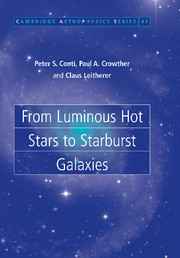Book contents
- Frontmatter
- Contents
- Preface
- Acknowledgements
- 1 Introduction
- 2 Observed properties
- 3 Stellar atmospheres
- 4 Stellar winds
- 5 Evolution of single stars
- 6 Binaries
- 7 Birth of massive stars and star clusters
- 8 The interstellar environment
- 9 From giant HII regions to HII galaxies
- 10 Starburst phenomena
- 11 Cosmological implications
- References
- Acronyms
- Symbols
- Object index
- Subject index
5 - Evolution of single stars
Published online by Cambridge University Press: 28 October 2009
- Frontmatter
- Contents
- Preface
- Acknowledgements
- 1 Introduction
- 2 Observed properties
- 3 Stellar atmospheres
- 4 Stellar winds
- 5 Evolution of single stars
- 6 Binaries
- 7 Birth of massive stars and star clusters
- 8 The interstellar environment
- 9 From giant HII regions to HII galaxies
- 10 Starburst phenomena
- 11 Cosmological implications
- References
- Acronyms
- Symbols
- Object index
- Subject index
Summary
In this chapter we discuss the evolution of massive stars (≥ 8M⊙) from their Main Sequence through their chemically evolved supergiant phases, to their ultimate demise as supernovae. The birth of massive stars is deferred until Chapter 7, and gamma ray bursts are discussed in Chapter 11.
The physical scale of stellar masses results from gravity and stellar structure considerations, whilst the ability for stars to maintain their hydrostatic equilibrium over millions or billions of years is as a consequence of the properties of their atomic nuclei. For non-degenerate stars the energy radiated is extracted from either their gravitational or nuclear reservoir. Gravitational contraction maintains mechanical equilibrium over a Kelvin–Helmholtz timescale, tKH, whilst the nuclear energy source can sustain the stellar luminosity during much longer times. Schematically, there exist four ranges of stellar mass, those that undergo (i) no nuclear burning (brown dwarfs, ≤ 0.08M⊙); (ii) hydrogen burning (0.08–0.5 M⊙); (iii) hydrogen and helium burning (0.5 –8 M⊙); (iv) beyond helium burning (≥ 8M⊙). Of these, solely the final mass range is discussed here, since low and intermediate mass stars are widely discussed in the literature (e.g. Iben 1967). A modern review of massive stellar evolution is provided by Maeder & Meynet (2000).
Nucleosynthesis
Arnould & Takahashi (1999) provide a modern review of nuclear astrophysics.
- Type
- Chapter
- Information
- From Luminous Hot Stars to Starburst Galaxies , pp. 99 - 128Publisher: Cambridge University PressPrint publication year: 2008

